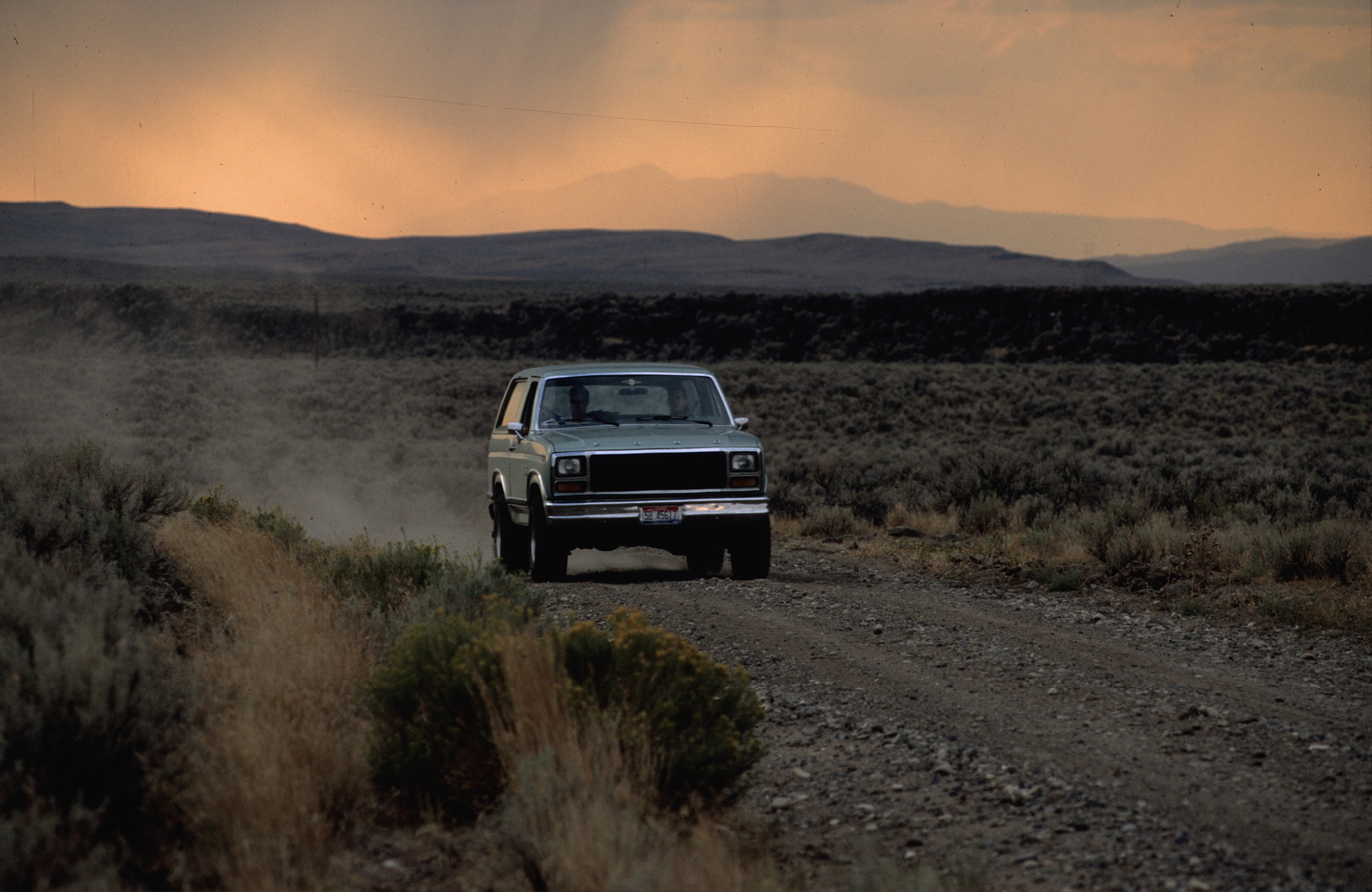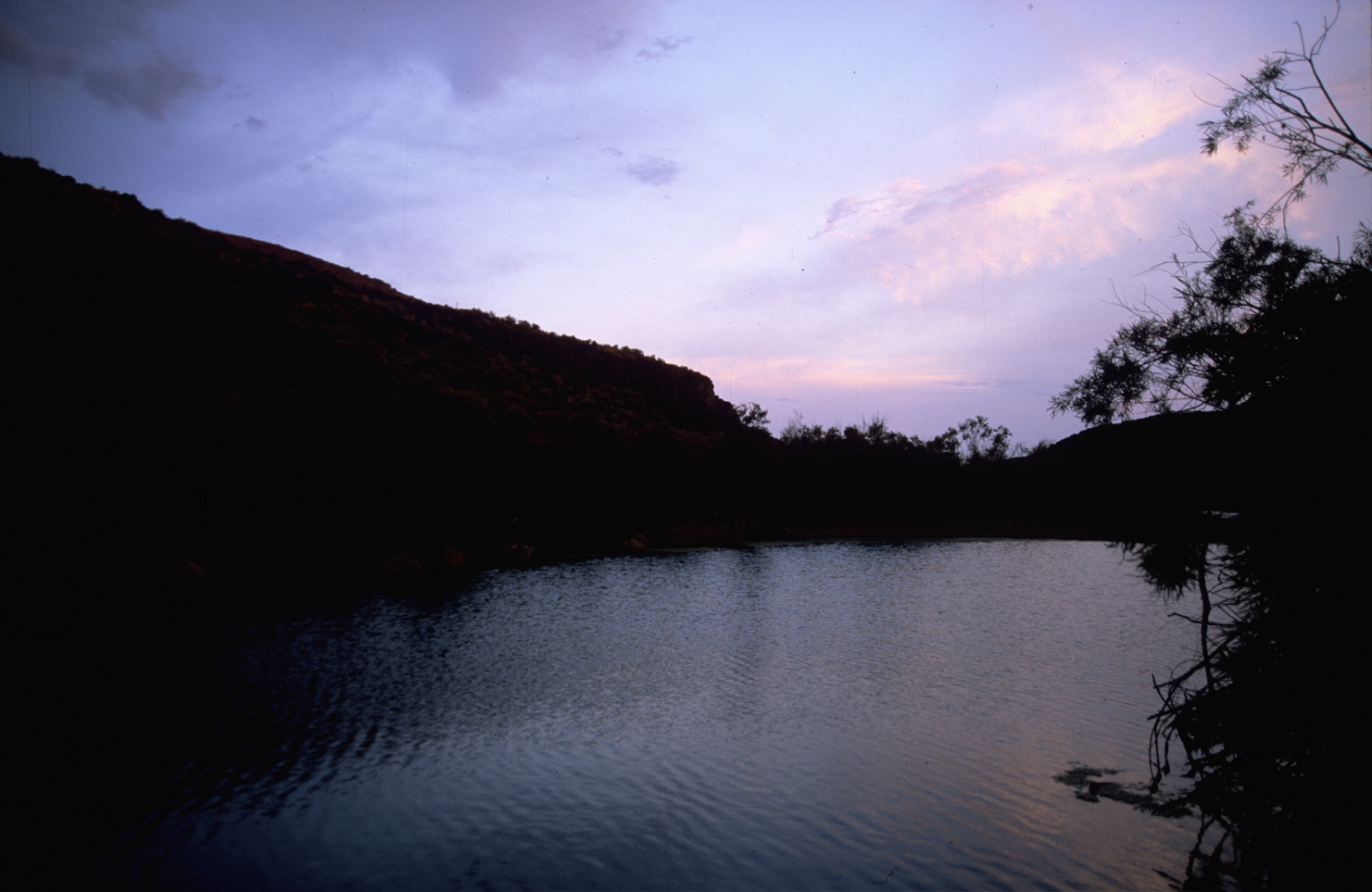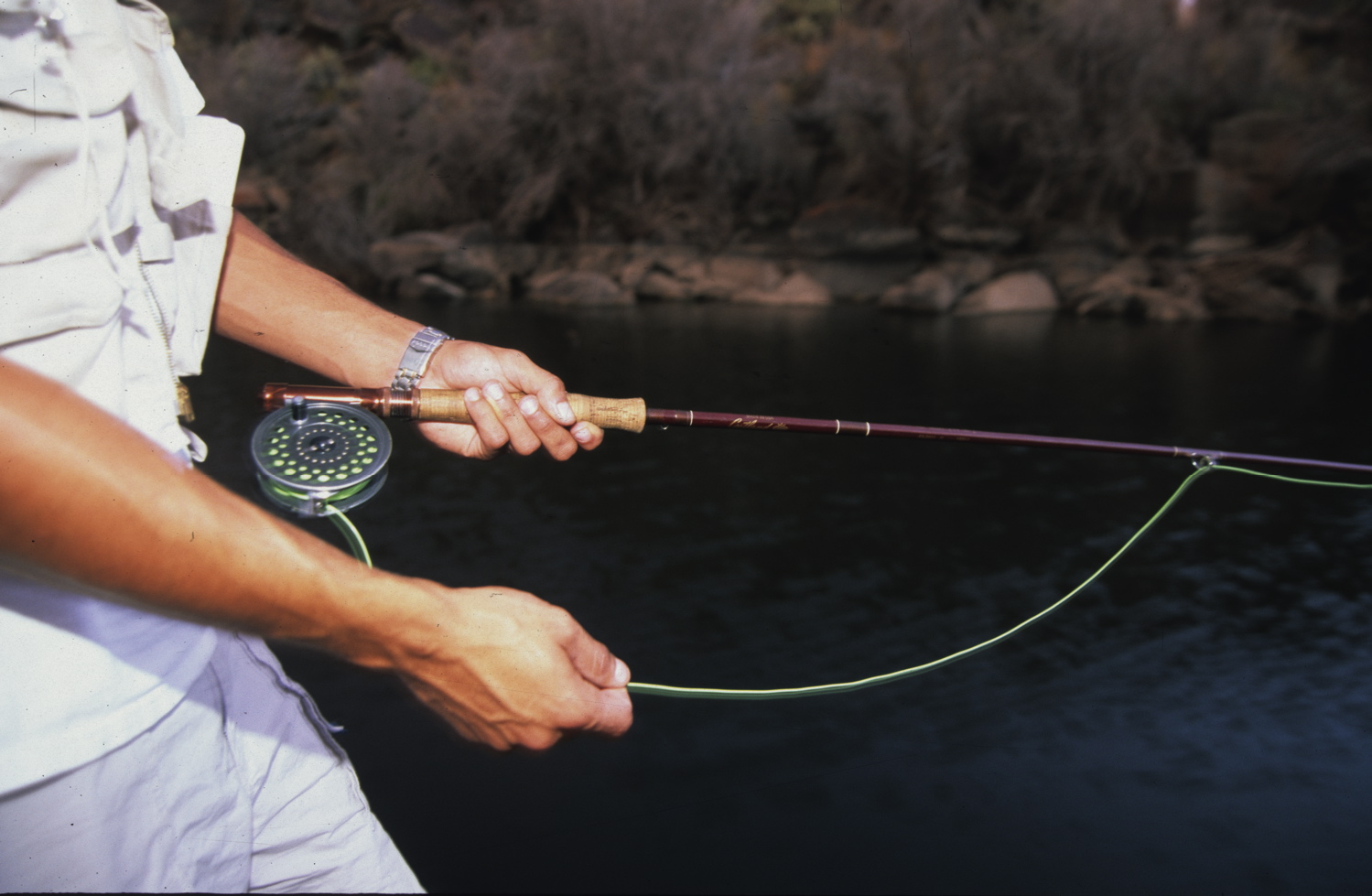Western Drought Devastates Idaho Fishery
Andrew Rigging RoD
“In early August the first pool is the largest and requires a float tube to reach the middle.”
Andrew Casting
“To my credit, I never let him forget that big fish and we would laugh at his look of bewildered disbelief when the line went slack.”
“In the twenty-five years I have fished this pool, river flows have never failed to provide sufficient oxygen and shrimp to help the trout survive through winter to the next spring.”
ANDREW WITH A RAINBOW TROUT
“The big fish have started to move and Andrew takes a single tug on his line before his rod arcs toward the water. A deep, heavy splash boils the surface and he holds the rod above his head and
strips in the slack.”
“The time isn’t right to tell my son that I believe his grandfather lives on in him.”
It does no good to fish the canyon in the mid-day when the hot August sun drives the big trout down into the cool, deep holes where they wait for the shadows to lengthen and the shrimp to leave the weed beds that crowd the banks. The big trout will not start to feed until the shadows scale the cliff walls and true dark rolls across the water. When stars speckle the indigo cleft between the black walls, the rises will grow deeper, more powerful and serious. It is a sign that the big fish have left the deep holes and are now cruising close beneath the surface. That is why we do not leave until an hour after Andrew returns home from his job and I have turned off my computer.
The directions to this basalt cleft have been passed from generations of fisherman, to fisherman to Ray Kamo who asked me to keep his secret. I know Ray would make an exception for my sons and it is late afternoon when Andrew and I follow Ray’s old route into the desert. Andrew, as always, drives too fast down the dusty road that snakes between the lava flows. He keeps his foot on the throttle as he follows the labyrinth of left and rights through the black rock, desiccated sage and dry bitter brush. Coming into a wash boarded corner the Bronco pitches sideways, kicking up clouds of dust which float like talc in the still evening air.
Half an hour after leaving the main highway, we stop in a turnout and walk to the canyon’s cliff edge. A week has passed since the water master closed a massive valve, leaving a series of deep, silent pools strung like dark emeralds down the narrow gorge. Even from five hundred feet away we can see the rings of rising trout. Sheltered by willows and filled with deep holes, fishing the canyon when the current roars over the basalt ledges is a dicey proposition. I have known more than one angler who flipped his float tube, lost his rod and nearly drowned trying to reach the shore.
Canyon Night
In early August the first pool is the largest and requires a float tube to reach the middle. The second pool is hundred yards long, fifty feet wide and overhung with willows. A rocky bar and thick weed beds define the downstream bank and it is here that the trout are rising.
Andrew slips his rod from the case, tosses me the keys and starts down the twisting path. From the desert road to the canyon trail, labyrinth leads to labyrinth and I realize in the quarter century since I first negotiated the steep path my pace had grown a step slower, a degree less sure footed. For the first time I recognize the age in my balance, and silently fear the consequence of a misstep that will send me tumbling into the black boulders.
Locals call the canyon, “snaky.” Drawn by mice that live among the basalt boulders, rattlers bask in the late day heat. I can remember past afternoons when I wandered too near the perfectly camouflaged vipers and the sound of their sharp, staccato warnings sent my heart rate soaring. By the time I reach the pool, Andrew has tied on a Muddler Minnow and is casting across the still surface. Because he learned to cast while he was young, the fluency of his movements mirror the difference between someone who was born to a language and someone who studied it years later in school. I admire the perfect, graceful timing of rod and line as he sends the Muddler flying gracefully toward a rising trout’s heavy dimple.
He is using a Cortland fiberglass rod I bought for his grandfather Rob twenty years before. My father-in-law and I shared many things in common but fishing wasn’t one of them. Rob was a lure fisherman while I was a purist fly fisherman. In time I convinced him to lay aside his spinning rod and take up a fly rod. Starting at sixty-three, Rob truthfully never mastered the sport. His good nature, however, insisted he try and in those years I would bring him to this same pool and watch while he struggled with the timing of his cast until his line became hopelessly tangled around the tip.
Rob would eventually reel up and find a seat on one of the basalt boulders where he would watch me cast until, once in a great while, one of the giant, shrimp fed rainbows would inhale my green imitation. In those seconds after the heavy breeder felt the first sting of the hook, it would either bust off, explode across the surface in heavy deep splashes or sound for the deep bottom. While I landed some and lost many, Rob would marvel at the strength of the fish, and the beauty of the canyon. And then later, during the dusty drive out, we would retrieve a couple of Coronas from the cooler and marvel at the fishing.
I can’t remember that dad ever caught a big fish with a fly rod. In fact I can’t recall if he caught a fish at all on a fly. I do remember trolling along a rock wall in his aluminum boat when a huge trout grabbed the small spinner at the end of his line. Dad’s Hardy Princess reel let out a startled shriek and, before I could stop him, he grabbed the spool and reefed back on the rod. I had clipped the leader back and even tied in a swivel to handle the spinner but the rig was still far too light and the rod tip plunged viciously into the lake then straightened.
To my credit, I never let him forget that big fish and we would laugh at his look of bewildered disbelief when the line went slack.
ANDREW CASTING Rob Seely's Old RoD
When Rob grew too old to walk the Wood River, or climb down into the canyon he returned his fiberglass rod in hopes one of his grandsons could use it. By the time I bought Andrew a graphite rod for his twelfth birthday, Dad’s fiberglass stick was coated with ten years of dust in an upstairs closet. It might have stayed there if Andrew hadn’t broken his graphite tip and gone searching for Rob’s Cortland. Dad was eighty-eight when he died and now watching his grandson float the line across the still surface, I am glad Andrew broke the graphite tip. Like the canyon and this pool, the old, inexpensive fiberglass rod is an heirloom passed from generation to generation.
The canyon’s nutrient rich cold water stimulates the growth of fresh water shrimp. Hiding in black caves formed by the obtuse angles of massive basalt boulders, the ancient rainbows and ferocious browns grow heavy and old on the abundant feed. The shrimp draw the big fish slowly from bottom to top and by watching the strings of deep dimples, it is possible to mark their progress from the waning inflow, to the slow outflow.
In most years there would be a minimum water flow to sustain the big fish but a series of winter droughts has depleted the aquifer and the water master closed the valve a month early.
If you can believe the Idaho Fish and Game, the pool will continue to shrink until it finally goes dry. In the twenty-five years I have fished this pool, river flows have never failed to provide sufficient oxygen and shrimp to help the trout survive through winter to the next spring. But this year drought has gripped Idaho and the pool’s water temperature has risen, stressing the smaller rainbows and browns that now leap clear of the surface. The jumping speaks of a lack of oxygen within the rapidly shrinking pool and I wonder if the trout are trying to catch the caddis flying just above the surface? Or are they desperate to capture a few 02 molecules on their wet gills.
I regret the Fish and Game lacks a budget to save these huge breeders and wonder, in the scheme of a state budget, if trout are less valuable than forests? The fact is, it takes years to grow a big trout and a helicopter with a bucket could easily fly the breeders to nearby spring fed streams. But the Fish and Game are as stressed as the fish and need to balance the cost of helicopters against the loss of these big fish, their public relations value and the number of tourist dollars they bring to Idaho. If I had the deciding vote, would I spend millions to quench wilderness fires, while an equally valuable resource clings to life in warming pools? I’m afraid I’d go with the fish.
Andrew casts a perfect loop on across the water that floats the Muddler lightly onto the glassy surface. Stripping the line in with short, sharp tugs, his first cast fails to produce a rise. Nor does anything grab the fly for the next ten casts. I wonder if it is still too light to use a Muddler, if these ancient discriminating trout can detect tiny flaws of hair, feather or floss in the fly. I tie on a #16 green shrimp then cast to a large dimple. A trout immediately rises beneath it. The next five casts trigger rises but they are small fish and we did not drive this distance or scale the canyon walls to catch ten inch trout.
The shadows lengthen in the canyon and we start to catch larger fish, some a foot long, some longer. Fishing luck flows like subsurface currents and there is no predicting when fish will rise, to what or whether the hook, leader or knots will hold when the heavy rainbows turn and run from the rod. The big fish will remain hidden until true dark settles on the canyon, the Big Dipper spirals over head and the night’s full moon silvers the silent surface. We continue to catch and release fish until Andrew snags the willows with his back cast and breaks off his Muddler. Because I’m wearing the headlamp, I lend him my rod and while I focus the light on his tippet, watch him hook a nice brown.
I improve clinch another Muddler on his tippet then trade rods. On my next cast a drain opens under the tiny shrimp imitation and I feel massive, irresistible weight in the line. The first splash tells me it is an enormous fish and I keep the pressure on as the line hisses first one way, then another through the surface. The trout stays deep, runs hard and shakes against the hook’s sting. In time the runs grow shorter, the shaking stops and a gigantic rainbow hen appears in the shallows. She is as large as a steelhead and I realize if the water was colder and held more oxygen, I would have never landed her. She now lies exhausted on her side, and I slide one hand under her heavy belly and with the other grasp her thick tail. I am dumbfounded by her size and turning to Andrew ask, “Should I keep her?”
“She is going to die,” he says.
He is right. The pool will soon grow too warm to hold oxygen and within the next week this massive hen will float belly up to the surface. I accept the inevitability of her death in this pool, but I don’t want to kill her. As long as she is alive there is a chance that a freak summer rain will fill the river, charge the pools and buy time. Perhaps the fall rains will come early and this hen will live for another two or three years. Either way, I cannot kill her and release her back to the pool.
As much as I loved catching the hen, I am sorry I didn’t let Andrew keep my rod. I have caught enough fish in my life and knew the shrimp was working. When I tell him that the hen should have been his, that I should have let him use the rod until the rises stopped, he shakes his head then replies “There are no guarantees I would have hooked that fish.”
And then because fate does control the ebb and flow of fishing luck, Andrew casts his Muddler far out into the pool. It is now late evening and the stars are beginning to show above the canyon. The big fish have started to move and Andrew takes a single tug on his line before his rod arcs toward the water. A deep, heavy splash boils the surface and he holds the rod above his head and strips in the slack. It is a huge fish that rips up the pool from boulders to willows before diving to sulk in the deepest hole. When Andrew is finally able to move the fish off the bottom, it rises to the surface where it wallows until he is able to coax it into the shallows. It is a giant brown trout, the biggest I’ve seen. Twenty six inches and perhaps ten pounds, it is a spotted, golden freak living in this small pool. It is by far the biggest trout Andrew has ever hooked, or landed and in light of the shrinking water, I expect him to keep it. He gently places his hand under the Brown’s thick belly to gauge it’s girth and weight then asks me to hold his rod while he removes the Muddler. Then moving the fish in the water, he waits until the strength returns to its tail and releases it.
Neither of us speak. We know the chances of either of these fish surviving until next spring is slim. Watching the moon rise over the canyon wall, I suspect if the fish had a choice, it would take its chances. As true dark settles in the canyon we catch other big trout. None as big as the rainbow or brown. A couple are eighteen inches, some are shorter. It is 10:30 at night when the bite ends and Andrew and I reel up and climb to the canyon rim. On the ride out we share a Corona and talk about fishing and the fish.
BRonco Headed To Canyon
The time isn’t right to tell my son that I believe his grandfather lives on in him. I am positive that, for tonight at least, Rob was part of the canyon, the Cortland and Andrew long perfect casts. And catching a hint of my father-in-law’s smile as my son describes how the fish hit the Muddler, I am pleased that the brown was Rob’s first trout on a fly.



